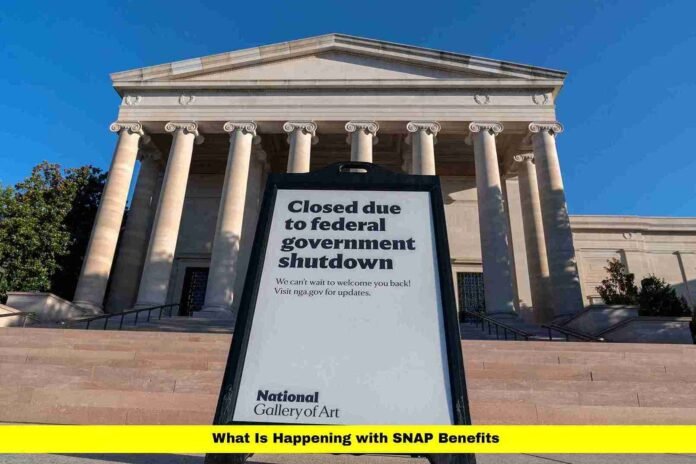Millions of Americans are facing uncertainty as questions mount about what is happening with SNAP benefits. The ongoing federal government shutdown has put the Supplemental Nutrition Assistance Program (SNAP) at risk, potentially delaying or halting benefit distributions for millions of low-income households. With November approaching, recipients are seeking clarity on how this disruption will affect their access to essential food support.
Why SNAP Benefits Are at Risk
The current government shutdown has disrupted funding for many federal programs, including SNAP. While October benefits were issued as usual, federal officials have warned that funding for November may not be available. Without congressional approval to continue appropriations, states may not receive the necessary federal resources to process payments. This has created uncertainty for recipients who rely on SNAP as their primary source of food support.
SNAP operates as a federally funded program administered by states, which means states cannot distribute benefits without federal funding. Any delay or halt in the flow of funds directly impacts households, leaving families without the resources needed to purchase groceries. This risk highlights how critical federal appropriations are to maintaining food security for vulnerable populations.
States Most Affected by Potential Halts
Several states have already begun preparing for the possibility that SNAP benefits may be delayed or paused. States including Pennsylvania, Texas, Illinois, and California have issued warnings that recipients should prepare for potential disruptions. Other states have indicated that while benefits may continue temporarily, they remain at risk if the shutdown continues into November.
State agencies are working internally to manage potential gaps, but there is no guarantee that they can cover the shortfall. This uncertainty is causing concern among recipients who depend on SNAP to meet basic nutritional needs. By proactively communicating with residents, states are advising households to plan ahead and explore alternative food resources if benefits are interrupted.
Impact on Low-Income Households
A halt or delay in SNAP benefits would have significant consequences for low-income families. Many households rely on these monthly payments to purchase groceries and provide essential nutrition. Without timely access to funds, families may be forced to cut back on meals or rely heavily on local food pantries and community support programs.
Children, seniors, and individuals with disabilities are particularly vulnerable. For these populations, consistent access to SNAP benefits is critical to maintaining health and nutrition. Any disruption can exacerbate food insecurity and increase stress on households already facing financial challenges. The broader community may also feel the impact as food banks and nonprofit organizations experience higher demand during a disruption.
Steps Recipients Can Take
SNAP recipients can take proactive steps to prepare for potential disruptions. Budgeting any remaining EBT funds carefully can help extend resources until benefits are restored. Households should also connect with local food banks, community centers, and nonprofit organizations for additional support during the halt.
Staying informed is essential. Recipients should monitor communications from state social services departments for updates on benefit distributions. Additionally, reaching out to local representatives to emphasize the importance of restoring federal funding can contribute to faster resolution of the shutdown. Being proactive helps households navigate this period of uncertainty more effectively.
State Contingency Measures
State agencies are exploring ways to support residents if SNAP benefits are interrupted. Contingency plans may include collaboration with local food banks and community organizations to ensure households have access to emergency food assistance. Some states are also evaluating temporary programs to provide supplemental support for the most vulnerable families.
Although these measures cannot fully replace SNAP benefits, they are intended to reduce immediate hardship. State officials are emphasizing the importance of planning ahead and encouraging recipients to utilize available resources during the pause. Early preparation can help minimize the disruption’s impact on families and communities.
How Long Could Disruptions Last?
The length of any SNAP disruption will depend on the resolution of the federal government shutdown. If funding is restored quickly, states may be able to issue benefits on schedule. However, if the shutdown continues into November, delays or temporary halts could extend for several weeks.
Households should consider emergency planning, such as maintaining food supplies and using community resources. Being prepared for both short-term and extended interruptions allows families to navigate this uncertain period with less disruption to daily life. Monitoring state updates is critical for understanding the timeline and any changes in benefit issuance.
Long-Term Implications
The potential halt of SNAP benefits underscores the broader effects of federal shutdowns on social programs. Millions of households rely on SNAP to maintain access to food, and even a short-term interruption can increase food insecurity and strain community support systems. Consistent funding is essential to ensure that these programs operate smoothly and protect vulnerable populations from economic hardship.
Prolonged disruptions could also have long-term consequences for public health. Children and seniors are particularly at risk if access to nutrition is interrupted, and communities may face increased demand on food assistance programs. Stable funding and timely distribution of SNAP benefits are therefore critical to maintaining both individual and community well-being.
Looking Ahead
The situation surrounding SNAP benefits remains fluid, and recipients must stay informed and prepared. Proactive budgeting, engagement with local food assistance programs, and monitoring state updates are essential steps for navigating potential disruptions. Advocacy with elected officials can also help accelerate the resolution of funding issues.
Ultimately, the continuation or resolution of the government shutdown will determine whether SNAP benefits continue as scheduled or experience delays. Households are encouraged to take precautions now to minimize the impact and ensure continued access to essential food support. Staying proactive and utilizing available resources is the best way to manage this period of uncertainty.
